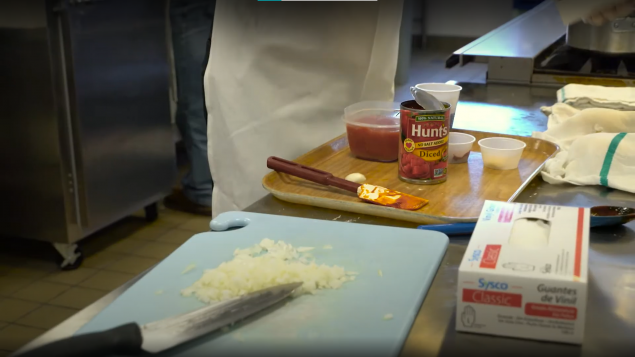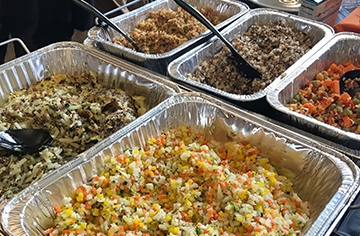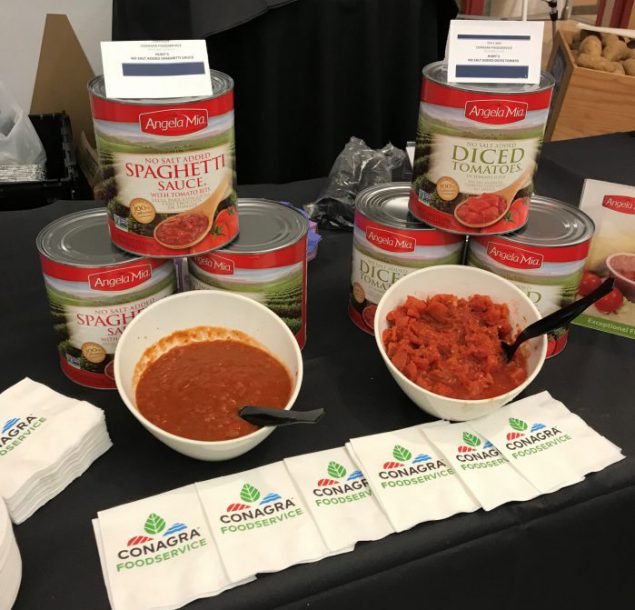Onondaga County Promotes Heart-Healthy Food in Community Organizations
Download the story [PDF – 506 KB]

OCHD and Syracuse University sponsored hands-on food preparation workshops. Watch more about the workshops.
Hypertension, also known as high blood pressure, is a major health problem in the United States.1 Diet—specifically high levels of sodium in the foods we eat—plays a major role in the development of hypertension, but many people either cannot get or do not know about lower sodium food options.2
The Onondaga County Health Department (OCHD) recognized both how many people in the community have hypertension and the lack of lower sodium food options in its community institutions. To address the issue, OCHD worked with food vendors and food service staff at these institutions to provide more lower sodium food options.
Public Health Challenge
One in two adults in the United States has hypertension.3 However, in Onondaga County, New York, nearly one third of residents have hypertension, which contributes to 28% of all deaths in the county.4 One strategy for controlling or preventing hypertension is to consume less sodium; however, many options provided by food service companies at health care, education, and other community institutions are high in sodium and are not nutritious.
Approach

At the Heart-Healthy Food Show, vendors set up tables with products lower in salt, fat, and sugar, where attendees asked questions while sampling foods.
OCHD hosted a Heart-Healthy Food Show to bring together food vendors and food service staff from community institutions in Central New York to learn about lower sodium foods and other healthy food options.
The food service staff who attended were from a variety of community organizations, including daycare centers, preschools, schools, early childhood education centers, colleges, universities, hospitals, nursing homes, assisted living facilities, community agencies, corner stores, and correctional facilities.
OCHD invited vendors who sold food products that comply with the New York City Department of Health and Mental Hygiene’s Good Choice Criteria [PDF – 355 KB]. Good Choice provides nutrition guidelines for healthy levels of nutrients in various foods, including prepackaged snacks and prepared foods. Vendors were asked to display and provide samples of products that were lower in sugar, salt, and fat. The food show also featured 15-minute nutrition education classes led by local nutrition undergraduate students, focused on the effects of excess sugar, salt, and fat on health.
Results

One of the 17 vendors at the Heart-Healthy Food Show, exhibiting a no salt added food product.
The Heart-Healthy Food Show was well attended and featured almost 17 vendors exhibiting 100 healthy food products. On average, each vendor gained up to 30 new customers. Among food service staff who attended the nutrition education classes, 100% reported that they learned something new.
All the attendees and vendors stated that they would attend future Heart-Healthy Food Shows, and 93% of the attendees reported that they intended to make product and menu changes learned at the Heart-Healthy Food Show.
We changed a lot in our early childhood education center: whole grain bread, lower sodium ketchup, Caesar dressing, chicken, lower sodium spaghetti sauce, lower sodium pizza shells, and wraps. So many things we changed on our menu.
What’s Next
Because of the success from the first Heart-Healthy Food Show, OCHD has continued to host food shows to promote healthier food options in community settings. In 2020 and 2021, OCHD moved the food show to a virtual format due to the COVID-19 pandemic, and the event remained successful.
Connecting institutions with food vendor companies can help make lower sodium and other heart-healthy foods accessible to people who eat in community settings. Healthy food options can help adults who live or work in these settings manage or prevent hypertension. Kids who are exposed to lower sodium foods in schools may enjoy and continue to eat these foods throughout their lives and thereby reduce their risk for hypertension as adults.5
Find Out More
OCHD and Syracuse University (SU) sponsored two hands-on food preparation workshops led by Chef Bill Collins at SU’s Susan R. Klenk Learning Café and Kitchens. Watch and learn the approaches the workshops taught to reduce sodium in menu items across Onondaga County institutions.
Learn more about Onondaga County Health Department.
Use the SRCP Implementation Guide to apply sodium reduction strategies derived from the SRCP into your communities.
References
- CDC. High Blood Pressure. Accessed August 8, 2021.
- CDC. High Blood Pressure Symptoms and Causes. Accessed August 8, 2021.
- Million Hearts. Estimated Hypertension Prevalence, Treatment, and Control Among U.S. Adults. Accessed August 8, 2021.
- CDC. 2016 BRFSS Survey Data and Documentation. Accessed August 8, 2021.
- CDC. High Blood Pressure in Kids and Teens. Accessed August 8, 2021.
